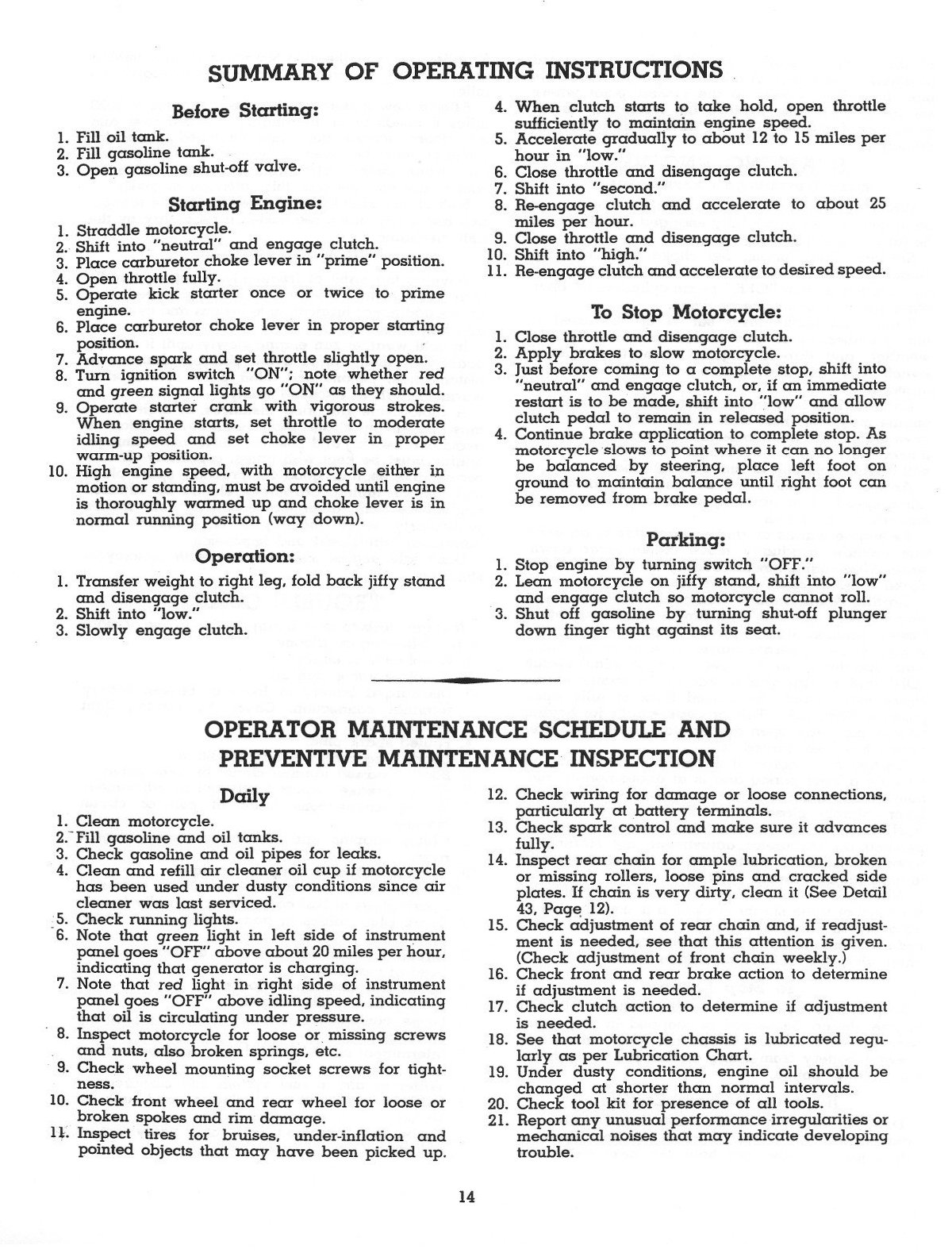p14 (24)

SUMMARY OF OPERATING INSTRUCTIONS
Before Starting:
1. Fili oil tank.
2. Fili gasoline tank.
3. Open gasoline shut-off valve.
Starting Engine:
1. Straddle motorcycle.
2. Shift into "neutral" and engage clutch.
3. Place carburetor choke lever in "prime" position.
4. Open throttle fully.
5. Operate kick starter once or twice to prime engine.
6. Place carburetor choke lever in proper starting position.
7. Advance spark and set throttle slightly open.
8. Tura ignition switch "ON''; notę whether red and green signal lights go "ON" as they should.
9. Operate starter crank with vigorous strokes. When engine starts, set throttle to moderate idling speed and set choke lever in proper warm-up position.
10. High engine speed, with motorcycle either in motion or standing, must be avoided until engine is thoroughly warmed up and choke lever is in normal running position (way down).
Operation:
1. Transfer weight to right leg, fold back jiffy stand and disengage clutch.
2. Shift into "Iow."
3. Slowly engage clutch.
4. When clutch starts to take hołd, open throttle sufficiently to maintain engine speed.
5. Accelerate gradually to about 12 to 15 miles per hour in "Iow."
6. Close throttle and disengage clutch.
7. Shift into "second."
8. Re-engage clutch and accelerate to about 25 miles per hour.
9. Close throttle and disengage clutch.
10. Shift into "high."
11. Re-engage clutch and accelerate to desired speed.
To Stop Motorcycle:
1. Close throttle and disengage clutch.
2. Apply brakes to slow motorcycle.
3. Just before coming to a complete stop, shift into "neutral" and engage clutch, or, if an immediate restart is to be madę, shift into "Iow" and allow clutch pedał to remain in released position.
4. Continue brake application to complete stop. As motorcycle slows to point where it can no longer be balanced by steering, place left foot on ground to maintain balance until right foot can be removed from brake pedał.
Parking:
1. Stop engine by tuming switch "OFF."
2. Lecm motorcycle on jiffy stand, shift into "Iow" and engage clutch so motorcycle cannot roli.
3. Shut off gasoline by turning shut-off plunger down finger tight against its seat.
OPERATOR MAINTENANCE SCHEDULE AND PREYENTIYE MAINTENANCE INSPECTION
Daily
1. Clean motorcycle.
2. Fili gasoline and oil tanks.
3. Check gasoline and oil pipes for leaks.
4. Clean and refill air cleaner oil cup if motorcycle has been used under dusty conditions sińce air cleaner was last serviced.
5. Check running lights.
6. Notę that green light in left side of instrument panel goes "OFF" above about 20 miles per hour, indicating that generator is charging.
7. Notę that red light in right side of instrument panel goes "OFF" above idling speed, indicating that oil is circulating under pressure.
8. Inspect motorcycle for loose or missing screws and nuts, also broken springs, etc.
9. Check wheel mounting socket screws for tight-ness.
10. Check front wheel and rear wheel for loose or broken spokes and rim damage.
U. Inspect tires for bruises, under-inflation and pointed objects that may have been picked up.
12. Check wiring for damage or loose connections, particularly at battery terminals.
13. Check spark control and make surę it advances fully.
14. Inspect rear chain for ample lubrication, broken or missing rollers, loose pins and cracked side plates. If chain is very dirty, clean it (See Detail 43, Page 12).
15. Check adjustment of rear chain and, if readjust-ment is needed, see that this attention is given. (Check adjustment of front chain weekly.)
16. Check front and rear brake action to determine if adjustment is needed.
17. Check clutch action to determine if adjustment is needed.
18. See that motorcycle chassis is lubricated regu-larly as per Lubrication Chart.
19. Under dusty conditions, engine oil should be changed at shorter than normal intervals.
20. Check tool kit for presence of all tools.
21. Report any unusual performance irregularities or mechanical noises that may indicate developing trouble.
14
Wyszukiwarka
Podobne podstrony:
Summary of functions operating on raw memory ■ memccpycopies a błock of n byt
00035 ?241034634b4e2dd3fb05e21831301a 34 Moinau A summary of chosen tests parameters: lead CUSUM 2n
img111 Summary of Exercises Basic Bounce LJIl Toe Raise Shoulder Shrug xV-) ( )n Front FootTap ii—.
Sony4300 1 3-044-359-41 (1) GB a PL TR RU SONYFM/MW/LWCar Stereo Operating Instructions Navod k
TheStereo Disc Today By SIDNEY FREY Pretident, Audio Fidelity, Inc. Summary of presenł status of ste
Frequency Rangę International Region 3 Allocation New Zealand Allocation Summary of Usage Reterences
Frequency Rangę International Region 3 Allocation New Zealand Allocation Summary of Usage References
Frequency Rangę International Region 3 Allocation New Zealand Allocation Summary of Usage References
Frequency Rangę International Region 3 Allocation New Zealand Allocation Summary of Usage References
Frequency Rangę International Region 3 Allocation New Zealand Allocation Summary of Usage References
Frequency Rangę International Region 3 Allocation New Zealand Allocation Summary of Usage References
Frequency Rangę International Region 3 Allocation New Zealand Allocation Summary of Usage References
Summary of Key?counts Summary of Key Acconnts r«*iły OttMIt
[301] Jakub KOLCZYŃSKI: ‘Design of operationnal amplifier with Iow power consumpti
PLATĘ 24. Mechanics of the eyes 53
15 8 Summary of the course: Negotiations lead to an agreement. It is the situation when two parties
INVESTMENT PROPOSALS OF MYKOLAYIV REGION INDUSTRY DEEP-WATER ESTUARY PORT IN DNIPRO LIMAN Short su
więcej podobnych podstron